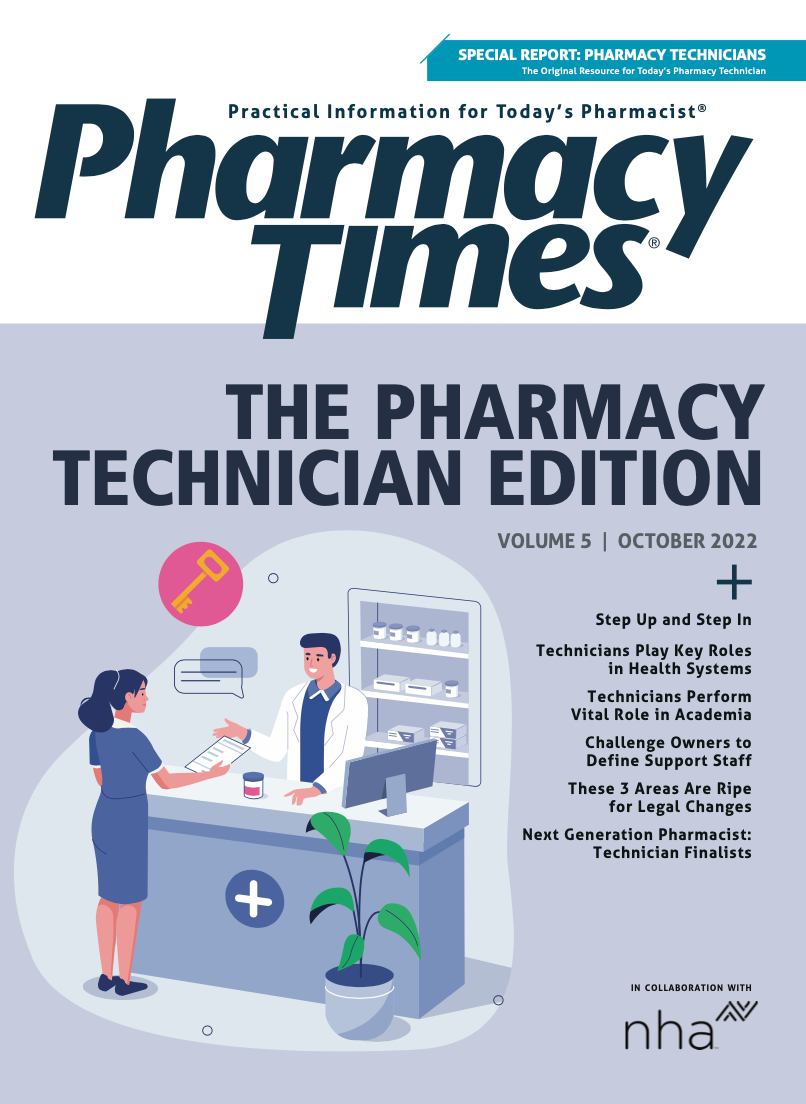Publication
Article
Supplements
These 3 Areas of Opportunity Are Ripe for Law Changes
Author(s):
Modifications related to final product verifications, immunizations, and remote work loom on the horizon for 2023.
The pharmacy profession is at a crossroads, and the past 5 years are proof that an evolution is occurring.
As most of society continues to experience economic uncertainty, supply chain challenges, and workforce shortages, legislators and state boards of pharmacy have been dealt a fascinating hand of cards. One major question among rule and lawmakers has been, “What can we do?”
For pharmacy, challenges and pressure continue to mount across the country. The role of pharmacists, students, and technology continue to evolve, and pharmacy technicians play a critical part with patients and teams. As legislators and state boards of pharmacy climb uphill, there is movement toward solutions, progress, and wins, as seen nationwide.
Although many law and rule changes have occurred and will continue to do so, what follows are the top 3 areas of opportunity for impactful law changes in 2023 for technicians.
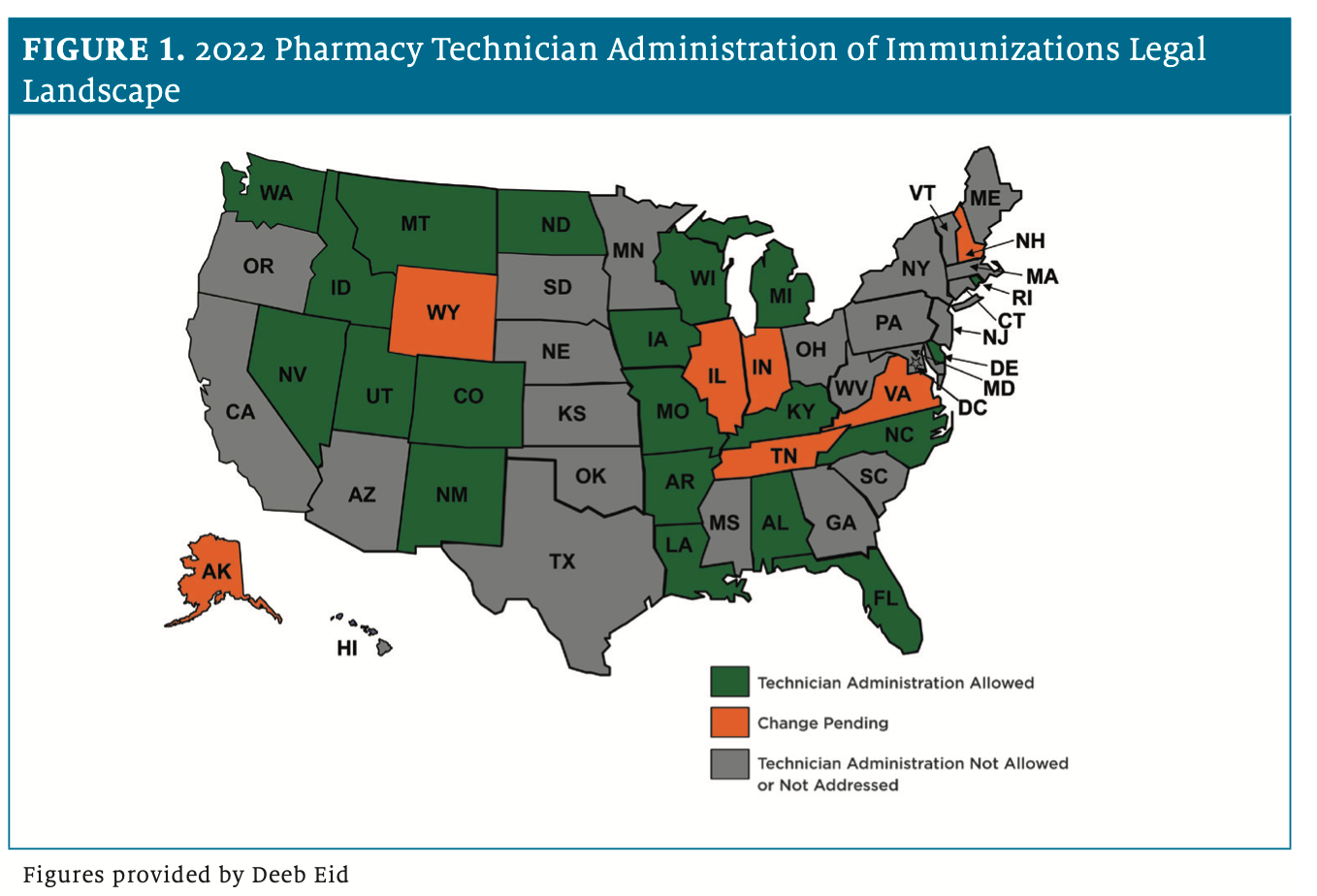
Technician-administered immunizations. Prior to the COVID-19 pandemic, 3 states, Idaho, Rhode Island, and Utah, led the way with changing laws, rules, or standing orders to allow technicians to administer immunizations. Drastic changesare seen when looking at a map and comparing 2019 and 2022.1-4 As of August 2022, 20 states have made changes or have allowances for technician immunization administration, and 6 are pending additional changes (Figures 1 and 2).1-4
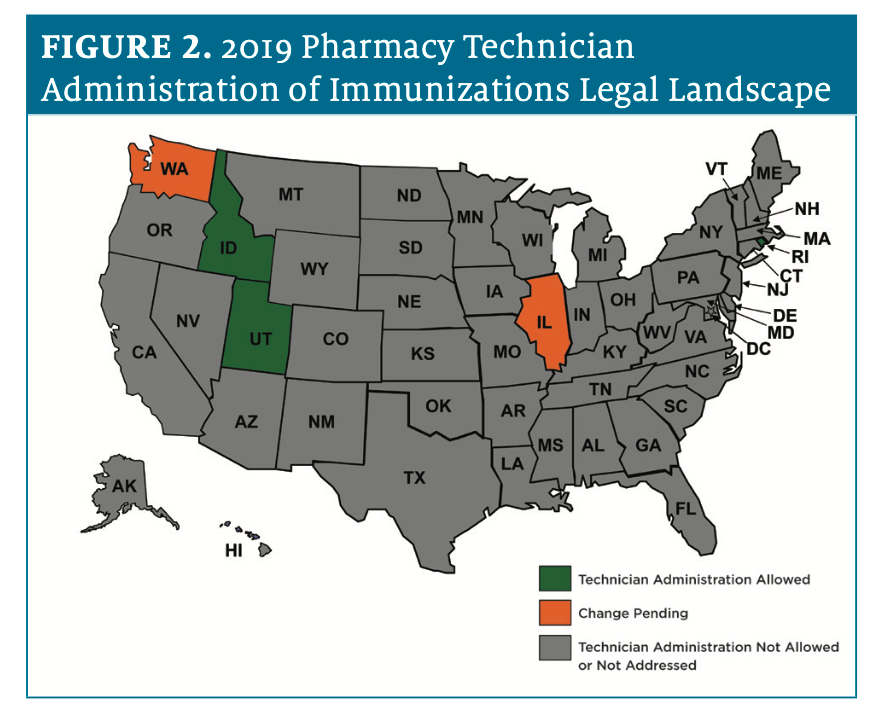
Multiple states have enacted permanent legal or rule changes related to technician immunization administration in 2022. They are Arkansas, Delaware, Florida, Iowa, Louisiana, North Carolina, and North Dakota. Alaska, Indiana, Illinois, Tennessee, and Wyoming have passed statutes and are waiting on rules to be written by state agencies. Others such as New Hampshire and Virginia have a bill or rule that goes into effect later this year. What about the remaining states? Many state legislative and regulatory barrierswere removed by the enactment of the Public Readiness and Emergency Preparedness Act5 that is set to expire in 2024—so time will tell if these states follow suit with permanent changes. Regardless, empowering technicians with this role has been shown to increase accessibility to vaccines, allow for added assistance, and shown little concern for patient safety overall.6-9
Remote work and work-from-home allowances. As pharmacies across the nationcontinue to face staffing, volume, and workload challenges, it is imperative to ensure that the distribution tasks are maximized.10 There are some responsibilities and roles, such as adjudication, answering phone calls, billing, and data entry, that can be completed remotely. To help relieve workload, reallocation of tasks to technicians who are working remotely with proper privacy and security is key. The pandemic forced lawmakers and regulators to keep open minds about emergency statutes and executive orders that opened the doors for remote work in many states. Twenty-five states have laws or rules that allow for remote work for technicians to varying degrees (Figure 3).11
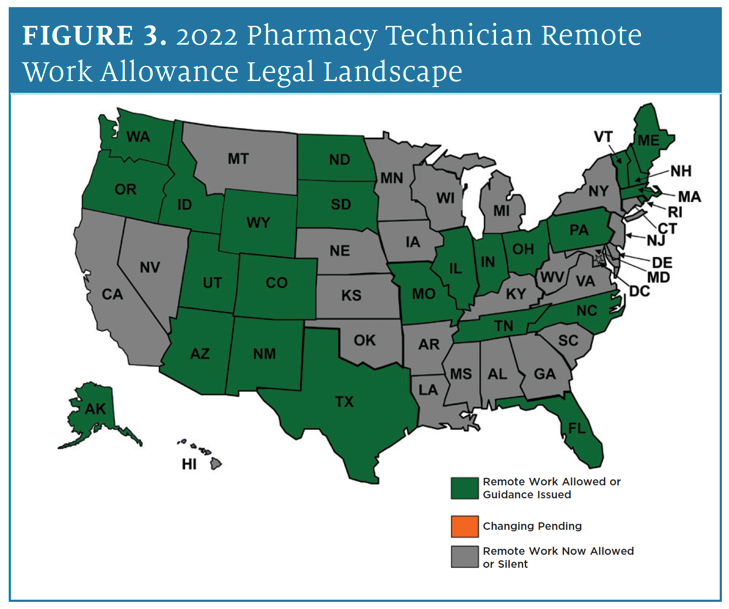
Alaska, Arizona, Colorado, North Carolina, and New Mexico have specific language addressing the topic. Maine and North Dakota related to remote work during boards of pharmacy meetings, as opposed to enacting permanent changes or rule changes to explicitly allow remote work.11 Other such as Alaska, Arizona, Colorado, New Mexico, and North Carolina have specific language that addresses the topic. It is important for lawmakers and state boards to continue to evaluate the impact that delegating certain administrative tasks, such as adjudication and data entry can have on relieving staff members who may be overwhelmed and overworked. Another consideration is around licensure and registration requirements, specifically how those are factors in practicing across state lines. In addition, businesses and organizations may want to consider the benefits and downsides with the flexibility of remote work or a hybrid model. Moving forward, this will be an impactful area to continue to track in 2023 and beyond.
Final product verification. This is also known as accuracy checking, tech-check-tech, or technician product verification. As pharmacies continue to experience an increase in overall prescription volume and as the population continues to grow, challenges arise with keeping up. The rise of central fill, kiosks, mail-order pharmacies, and automated medication devices all involve evolutionary automation and technology that assist with the technical tasks of dispensing. Yet pharmacists across the country still must juggle many tasks.10 The act of final product verification has been shown in more than 25-plus citable publication studies over more than 40 years of jurisdictional success that technicians who are trained on the task can perform at non-inferior accuracy rates to that of pharmacists.12-15 Delegation of this task to a technician frees up pharmacists to focus on clinical tasks. California, Kansas, Kentucky, and Montana allow technician product verification only in health system or institutional settings. Other states, such as Arizona, Iowa, Michigan, North Dakota, and Oregon, have moved away from limiting this role to a particular setting (Figure 4). Following an evidence-based approach, technicians can expand to this role in multiple settings. This provides for a huge opportunity for many other states to examine and expand a role that has been proven safe for more than 40 years. This is not meant to be a job killer or to replace pharmacists. The concept as depicted in multiple studies is to expand the team to allow for additional help, especially in times where workload is a concern.12-15
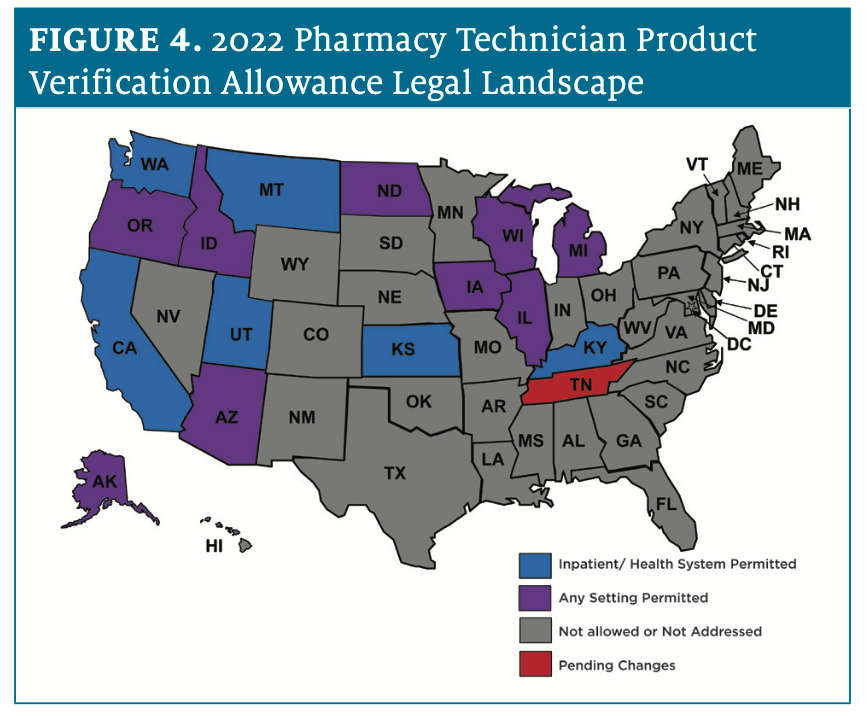
As the profession continues to face challenges, empowering technicians through enhancing their education, certification, training, and roles adds critical and dependable skills to pharmacy teams. As technicians take on more responsibilities, roles, and tasks, increasing their compensation from an average of $17.66 per hour and $36,740 per year16 will be imperative. Great opportunities await in 2023 for advocacy efforts to ensure that patients are safe, that pharmacy teams feel less pressured, and that we maximize our opportunities for change.
References
1. As of July 1, 2020, IDAPA 27.01.01 administrative rules of the Idaho State Board of Pharmacy have been redesignated as IDAPA 24.36.01. Idaho Office of the Administrator Rules Coordinator. Accessed September 22, 2022. https://adminrules.idaho.gov/rules/current/27/.
2.Pharmacists, pharmacies, and manufacturers, wholesalers, and distributors (216-RICR-40-15-1): administration of immunizations. Rhode Island Department of State. Accessed September 19, 2022. https://rules.sos.ri.gov/regulations/part/216-40-15-1
3. Vaccine administration protocol: standing order to administer immunizations and emergency medications. State of Utah Department of Commerce. Updated September 24, 2020. Accessed September 19, 2022. https://dopl.utah.gov/pharm/vaccine_administration_protocol.pdf
4. Utah Pharmacy Practice Act Rule 156-17(b)-621. Utah State Bulletin. October 15, 2019. Accessed September 19, 2022. https://dopl.utah.gov/laws/Prop_R156-17b_OAR_44108.pdf
5. Public Readiness and Emergency Preparedness (PREP) Act. US Department of Health & Human Services. Accessed September 19, 2022. https://www.phe.gov/Preparedness/legal/prepact/Pages/default.aspx
6. McKeirnan KC, Frazier KR, Nguyen M, MacLean LG. Training pharmacy technicians to administer immunizations. J Am Pharm Assoc (2003). 2018;58(2):174-178.e1. doi:10.1016/j.japh.2018.01.003
7. Berger K. Vaccines administered by certified pharmacy technicians in Idaho. Pharmacy Times®. March 28, 2018. Accessed August 24, 2022. https://www.pharmacytimes.com/view/vaccines-administered-by-certified-pharmacy-technicians-in-idaho
8. Bertsch TG, McKeirnan KC. Perceived benefit of immunization-trained technicians in the pharmacy workflow. Pharmacy (Basel). 2020;8(2):71. doi:10.3390/pharmacy8020071
9. Adams AJ, Desselle SP, McKeirnan KC. Pharmacy technician-administered vaccines: on perceptions and practice reality. Pharmacy (Basel). 2018;6(4):124. doi:10.3390/pharmacy6040124
10. APhA/NASPA National State Based Pharmacy Workplace Survey. American Pharmacists Association. December 2021. Accessed September 19, 2022. https://www.pharmacist.com/APhA-Press-Releases/apha-and-naspa-release-initial-findings-from-the-2022-national-pharmacy-workplace-survey
11. Guidance paper #01-2020: Maine Board of Pharmacy. Maine Department of Professional and Financial Regulation. April 18, 2020. Accessed September 19, 2022. https://www.maine.gov/pfr/professionallicensing/sites/maine.gov.pfr.professionallicensing/files/inline-files/guidance_paper_regarding_covid_19_from_board_meeting_held_april_10_2020.pdf
12. Andreski M, Myers M, Gainer K, Pudlo A. The Iowa new practice model: advancing technician roles to increase pharmacists’ time to provide patient care services. J Am Pharm Assoc (2003). 2018;58(3):268‐274.e1. doi:10.1016/j.japh.2018.02.005
13. Adams AJ, Martin SJ, Stolpe SF. “Tech‐check‐tech”: a review of the evidence on its safety and benefits. Am J Health Syst Pharm. 2011;68(19);1824-1833. doi:10.2146/ajhp110022
14. Frost TP, Adams AJ. Tech‐check‐tech in community pharmacy practice settings. J Pharm Tech. 2017;33(2):47-52. doi:10.1177/8755122516683519
15. Deeb D. Eid LinkedIn page. A summary for anyone still doubting technician product verification (also known as tech‐check‐tech). March 6, 2020. Accessed September 19, 2022. https://www.linkedin.com/pulse/summary-anyone-still-doubting-technician-product-verification-eid/
16. Pharmacy technicians. US Bureau of Labor Statistics. Updated September 8, 2022. Accessed September 19, 2022. https://www.bls.gov/ooh/healthcare/pharmacy-technicians.htm
Newsletter
Stay informed on drug updates, treatment guidelines, and pharmacy practice trends—subscribe to Pharmacy Times for weekly clinical insights.

